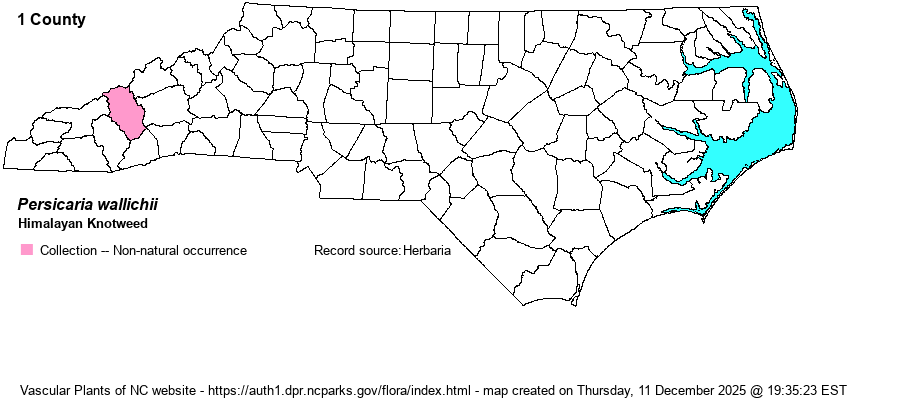| Author | Greuter & Burdet | |
| Distribution | A single population is known for NC: Haywood County, US route 23/74 at railroad grade just N of Balsam Gap. First collected by Dan Pittillo in 2002, then by Ron Lance in 2007.
Native of the Himalayan region; in N.A. in St. Pierre et Miquelon, MA, NC, CA, OR, B.C. | |
| Abundance | Very rare. | |
| Habitat | Roadside near railroad. | |
| Phenology | Flowering and fruiting September-October. | |
| Identification | Himalayan Knotweed is a perennial up to 3 feet tall. It has very long (4-9 inches) leaves with acuminate tips. The leaves tend to occur in one plane on the branches. The inflorescences are in upper axils and terminal, and are branched. The flowers are white or pinkish. | |
| Taxonomic Comments | Many species formerly treated in the genus Polygonum have been moved to Persicaria, the smartweeds. These are generally erect and tall plants with terminal and axillary floral spikes; most occur in wetlands. Others remain in Polygonum, the knotweeds, which are generally prostrate to ascending and with inconspicuous axillary flowers. They occur mostly in dry soils and tend to be weedy.
Attention must be paid to the small collars at the junction of the main stem and leaf stems (called ocreae) and whether they possess terminal hairs or bristles. Some keys also refer to the even smaller collars from which flowers emerge (called ocreolae). Another important ID character is the surface of the greenish sepals -- whether smooth or dotted with indentations (punctate). | |
| Other Common Name(s) | | |
| State Rank | SE | |
| Global Rank | GNR | |
| State Status | | |
| US Status | | |
| USACE-agcp | | |
| USACE-emp | FAC link |

